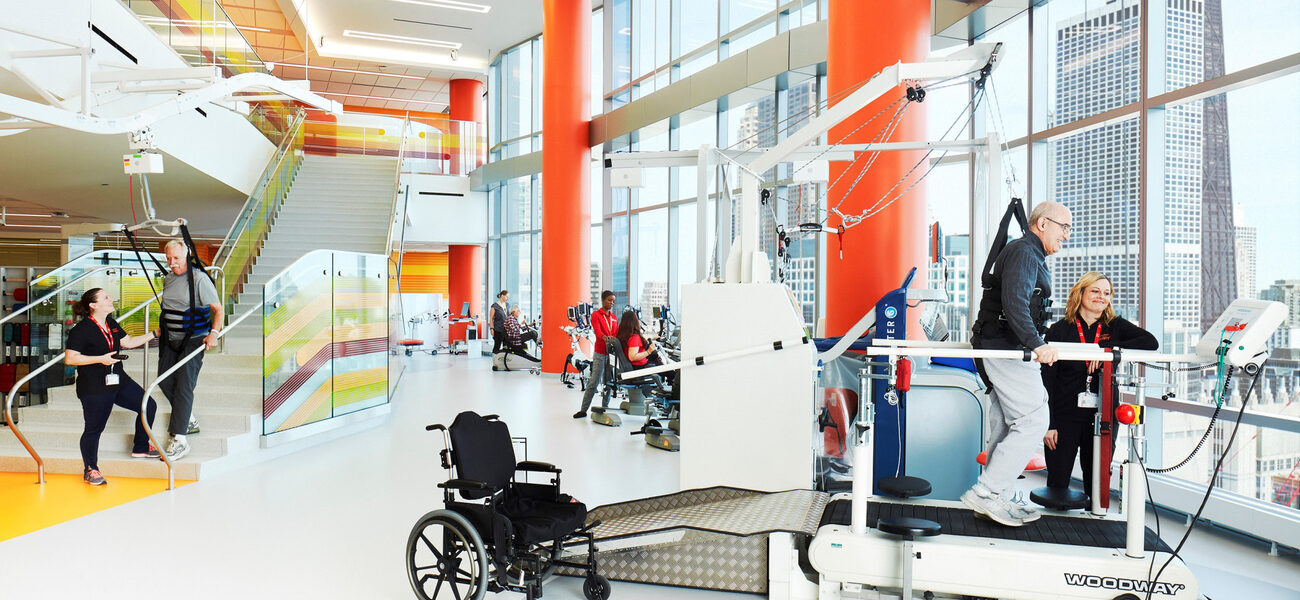Chicago’s newly opened Shirley Ryan AbilityLab is the world’s first translational research hospital where scientists, engineers, technologists, and clinicians work collaboratively with thousands of patients going through intensive post-traumatic and disease-related functional rehabilitation. This unique integrated model dramatically shortens the amount of time between research innovations and practical clinical applications.
The $550 million, 27-story facility opened in March 2017 and replaces the former Rehabilitation Institute of Chicago (RIC), which rebranded as the Shirley Ryan AbilityLab. The facility supports a one-of-a-kind multidisciplinary approach to combining science, engineering, technology development, and clinical care. It creates a “living lab” hospital that allows new research developments to become effective patient treatments more rapidly. The building and philosophy create a highly collaborative environment in which researchers can gain a more precise understanding of what patients need.
“Our care model is different because we’re embedding engineers and research scientists in the same space with doctors, therapists, nurses, and patients,” says Barry Fleischer, executive director of corporate strategy at Shirley Ryan AbilityLab. “It’s not just about having researchers and clinicians together. It’s about having them work together around actual patients 24 hours a day, seven days a week, to solve real-world problems in practical ways.”
The Shirley Ryan AbilityLab is the global leader in physical medicine and rehabilitation for adults and children with the most severe and complex conditions—from traumatic brain and spinal cord injury, to stroke, amputation, and disease-related functional (physical and cognitive) impairment. Its applied research focuses in the areas of neuroscience, bionic medicine, molecular and cellular biology, robotics, musculoskeletal medicine, pharmacotherapeutics, and technology transfer.
“We have the best clinical engine for rehabilitation in the world. We also have this powerhouse research enterprise, which is already, by NIH standards, the largest of its kind. We took the next step, however, and asked, ‘Can we do more for patients?’ We realized we shouldn’t be focusing on the process of rehabilitation, but instead on the individual outcome the patient wants. We needed to be bolder. We needed to take some risks,” says Fleischer.
The facility currently has 242 hospital beds and a revolving occupancy of approximately 200 patients who typically stay between 25 and 30 days, sometimes longer. Expansion space is provided for an ultimate capacity of 360 beds. An additional 50,000 sf of outpatient space is dedicated to providing orthopedic and sports injury rehabilitation, as well as neurological rehabilitation, such as post-stroke recovery, and other treatments for specific conditions, for example cerebral palsy, Parkinson’s disease, multiple sclerosis, arthritis, and chronic pain.
Faster Translation
One of the main drivers behind developing a unique model for translational medicine was reducing the amount of time it takes to go from scientific discovery to practical application.
“We translate things really poorly in biomedical science and engineering,” says Jon Crane, director of translational health sciences at HDR Architecture. “On average, it takes about 17 years to turn a new discovery into patient benefit, and there is an 86 percent failure rate. Part of our goal with the Shirley Ryan AbilityLab was to fundamentally change the game to make that process happen much better and faster.”
The result is five first-ever translational Ability Labs, each focused on a particular functional outcome: Think + Speak, Legs + Walking, Arms + Hands, Strength + Endurance, and Pediatric.
These translational labs are dynamic spaces in which interdisciplinary clinical and research teams use a wide range of therapeutic techniques and develop new research-based insights to help patients gain function, achieve better outcomes, and enjoy greater independence. Three of these labs occupy two stories. Together the Ability Labs account for more than 80,000 sf of advanced research, clinical, and rehabilitation space.
“We decided early on that if you’re trying to improve function after an injury or stroke, using MRI imaging to look at brain function could be a really important aspect of it,” says Crane.
“We’re already seeing some fascinating results. In one study, researchers are using functional MRI to study pain receptors in the brain. They give the patient an MRI to study differences in brain function based on pain. Now they’re looking at biomarkers in the brain, and whether you can predict someone’s response to pain treatment. It’s groundbreaking stuff that we’re learning from the get-go. Our clinicians don’t have to wait. That patient is in our labs working with us day to day,” says Fleischer.
Similarly, the Shirley Ryan AbilityLab Center for Bionic Medicine is the recognized world leader in the integration of targeted muscle reinnervation science, sensor technology, engineering, robotics and wireless technology. The center’s team is credited with developing the first bionic prosthetics (arms, hands, legs) that patients control with their thoughts, as well as many other innovations.
“That kind of development happens because the MDs and PhDs in charge of that lab are working directly with biomedical engineers, electrical engineers, occupational therapists, prosthetics people, and patients. And that’s exactly the kind of collaborative model we’re defining,” says Fleischer.
Designing for Serendipity
Designed by architecture firms HDR and Gensler, in association with Clive Wilkinson Architects, and EGG Office, the 1.2 million-sf building in downtown Chicago features multi-level integration of engineering, science, and medical care. Highlights include strategic clinical and research adjacencies with open work settings that give engineers and scientists direct ongoing exposure to patients in the clinical environment and vice versa.
“One of our early questions was: ‘How do you create opportunities for collaboration or serendipity?’” says Abigail Clary, a director of the health practice at HDR. “Serendipity needs fertile soil. You have to work at it. Part of that is making connections, but how do you make connections? It’s not just a matter of putting in a coffee bar. It’s about purposefully making spaces that draw certain individuals to them. The sky lobby and vertical spine are both great examples of that.”
A vertical spine of social spaces helps drive collaboration throughout the facility by drawing people to multiple floors. While the building’s 10th-floor sky lobby serves as the main reception area for all patients coming into the hospital, it also houses the administration and C-suite offices, as well as a conference center and retail tea shop. Instead of a traditional check-in desk, a uniformed concierge greets patients and visitors upon arrival and checks them in with an iPad.
“The sky lobby is alive all day long. It’s a pass-through for everybody in the organization. That floor brings more people together than many of the other floors,” says Clary.
“One thing that we learned about the research teams when we started working on this project, is that people who had been siloed in the old building would come into a meeting with us and start talking among each other saying things like, ‘I didn’t know you were doing that project. We need to get together on this.’ So just getting them together to talk about a new building was really important,” says Crane.
To eliminate silos in the new facility, not only are research departments co-located with strategic adjacencies designed to drive increased collaboration, but also many clinicians are part of research teams, which creates an additional level of integration.
“Studies show that if you locate department A next to department B, they will still only talk to each other less than 15 percent of the time. But if you take a few people and embed them in each other’s department, it increases their collaboration by as much as 200 percent. So, again, it’s about intentionally organizing space in a way that creates more opportunities for people to cross-pollinate,” says Clary.
Every Square Inch
The facility has five clinical “Innovation Centers” (Brain; Spinal Cord; Nerve, Muscle and Bone; Pediatric; and Cancer) where patients receive medical care, some types of therapy, and live during their stay. Four of the innovation centers are adjacent to the Ability Labs (Think + Speak, Arms + Hands, Legs + Walking, Strength + Endurance, and Pediatric). Three of the labs include a custom overhead track and body harness system that allows patients to safely navigate the two-level lab space and connecting staircase.
“One of the really important concepts for the building was that every square inch would be used to improve outcomes. For example, corridors are wider than normal, so patients can practice walking, balance, and endurance,” says Crane.
Patients are encouraged to maximize the number of steps they take every day—a regimen that has been shown to accelerate recovery. In fact, breakthroughs on gait therapy were made in the pilot of the translational model when it was housed in the old RIC building. The success of that translational pilot reaffirmed the vision for the Shirley Ryan AbilityLab.
“This is a perfect example of how a research breakthrough was used to inform even the design of the building. Every square inch really does advance ability,” says Crane.
Another question that came up during the planning process was whether the high-rise facility would have wet labs. Ultimately, 10,000 sf of wet lab space was included on the 26th floor, with beautiful views of Lake Michigan.
“Wet labs in a hospital are very unusual, but this is a very unusual building. It was decided that wet labs were important, because they are working with some great scientists in the biomedical engineering group and others across the street in Northwestern University labs. Including wet labs for biomechanics, genomics, biomaterials, and related biology research at the Shirley Ryan AbilityLab fosters stronger connections within the existing research communities at Northwestern,” says Crane.
Bridging Culture Gaps
One of the biggest challenges in developing this highly integrated model for translational medicine was bridging existing research and clinical cultures, as well as challenging the traditional approach to patient recovery.
“The new building was the tail on a long process of getting our culture to be open and willing to work this way. We joked about getting the Birkenstocks and the Suits together. Getting people comfortably culturally was probably the biggest hurdle,” says Fleischer.
“One of the most unusual things about this facility is that there are almost no offices in the building, and it is operating 24/7. There’s no place for anyone to hide. Dr. Joanne Smith, the president and CEO of the Shirley Ryan AbilityLab, says, ‘We want the research and clinical teams to feel the patient’s pain,’” says Crane.
“I think that transparency is really important from a patient perspective,” says Clary. “We talk a lot about patients being inspired by each other’s journey, but they can also be inspired by the research that is happening around them. It creates more desire for them to participate in the research when they can see what’s going on. It also gives them the confidence that they’re at the right place, with an organization that is really working toward a cure for whatever challenge they face.”
By Johnathon Allen


